In a previous article, we proposed for the first time a detailed analysis of the top certificates that were awarded by Takeda Sokaku to his students, showing that at several points in time, a number individuals could legitimately claim that they had been taught the full extent of Takeda's curriculum. In this follow up series of articles, we would like to focus not on the certificates, but on the scrolls that Sokaku awarded. This constitutes to the best of our knowledge the most extensive comparative analysis available publicly on the subject at this point.
Disclaimer: While I (Guillaume Erard), have provided sustained historical and archiving support to the author (Mihaly Dobroka), I have not discussed with him any technical point that pertain to Daito-ryu in general, or my own school, the Daito-ryu Aiki-jujutsu Shikoku Honbu in particular, and neither did I confirm or infirm some of his technical hypotheses and comparisons with his own knowledge of Aikido.
In koryu (古流, litt. "old schools"), makimono (巻物, litt. “scrolls”) are awarded to reflect the fact that a practitioner has reached a certain level of ability. Conventionally, koryu scrolls read from right to left and they usually contain the name of the school, a list of the techniques of a certain level of transmission, and the lineage of the school. These handwritten scrolls are usually issued by the soke (宗家, litt. “headmaster”) of the school and officialized by his stamp. Following this usage, Takeda Sokaku gave out various scrolls to his students during his long teaching career. Ueshiba Morihei, Sokaku’s most famous student and the founder of Aikido, received a total of three scrolls from his teacher.
Nowadays, though, it seems that most Daito-ryu schools no longer hand out these scrolls to their students and even for those who do, the teaching mostly does not occur according to the content of Sokaku’s scrolls. Although these constitute the earliest written documentation regarding Daito-ryu techniques, and in spite of their public diffusion, few people are actually knowledgeable about the content of these scrolls. Daito-ryu scrolls are interesting from an Aikido perspective as well. Ueshiba Morihei handed out Daito-ryu scrolls to his students before the war, and with slight modifications, occasionally even after the war. The precursors of many Aikido techniques are written in these scrolls, thus their study can provide valuable insight on Aikido might have evolved through time.
Recently, I took upon myself to translate into English several of Sokaku’s Daito-ryu scrolls and documents that are available publicly. In this article series, we are going to examine the content of those scrolls. We will highlight the evolution of Sokaku’s technical curriculum as well as its relation to modern-day Aikido techniques.
In Part 1, we are going to look into the first transmission scroll of Daito-ryu as known as Hiden Mokuroku. The scroll I chose for this study dates from the 19th century, which makes it the oldest one to our knowledge. First, let us focus on the technical content of the scroll and leave the discussion on the lineage to the topic of our next article. Based on his Eimeiroku records, Sokaku started to teach Daito-ryu in 1899.The following page is one of the earliest records of Daito-ryu training in the Eimeiroku. It is a record of a ten-day Daito-ryu Jujutsu seminar taught by Sokaku in 1899. Iwabuchi Giemon’s name is marked in red.
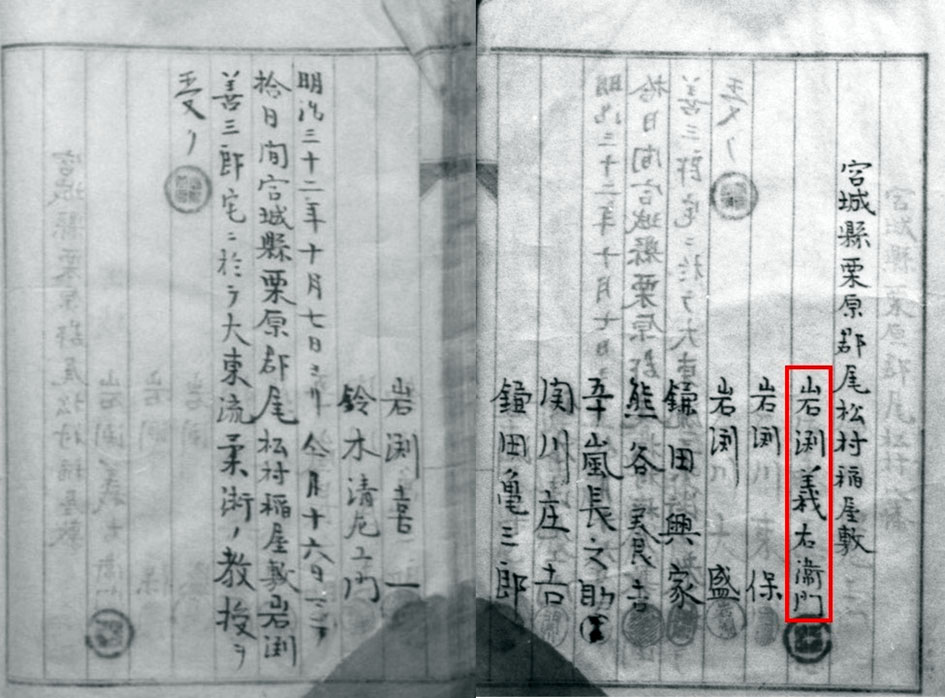 The entry records that the above ten people received instruction in Daito-ryu Jujutsu for ten days from 7 to 16 October 1899 at the Iwabuchi house, Omatsu village, Kurihara district, in Miyagi prefecture. Four members of the Iwabuchi family are on the list, the first (highlighted in red) is Iwabuchi Giemon (岩淵義右衛門).
The entry records that the above ten people received instruction in Daito-ryu Jujutsu for ten days from 7 to 16 October 1899 at the Iwabuchi house, Omatsu village, Kurihara district, in Miyagi prefecture. Four members of the Iwabuchi family are on the list, the first (highlighted in red) is Iwabuchi Giemon (岩淵義右衛門).
Giemon received simultaneously the first and second transmission scrolls from Sokaku in the month of November 1899, making him one of the earliest Kyoju Dairi in the history of Daito-ryu Jujutsu. Fortunately, Giemon’s scrolls survived, which make them the oldest known Daito-ryu documents given out by Sokaku.
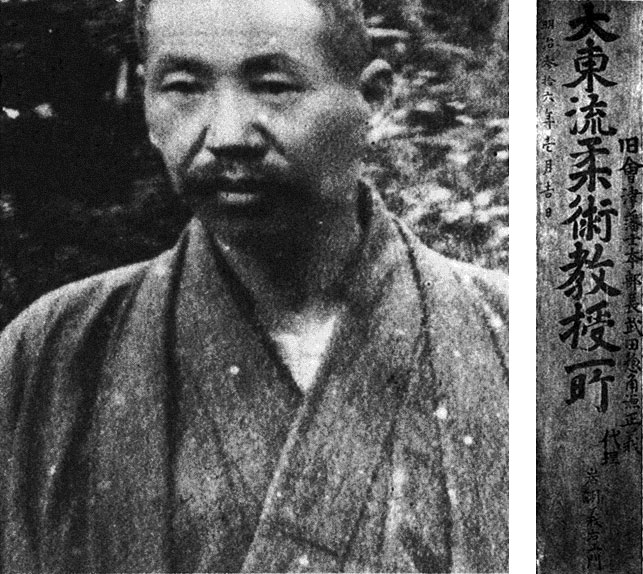 Iwabuchi Giemon. On the right, the signboard of Giemon's "Daito-ryu Jujutsu Kyojujo" (instruction place). His title is written as "Iwabuchi Giemon, representative of former Aizu Samurai and Hombu-cho Takeda Sokaku Minamoto no Masayoshi (武田惣角源正義)". The board is dated January 1903.
Iwabuchi Giemon. On the right, the signboard of Giemon's "Daito-ryu Jujutsu Kyojujo" (instruction place). His title is written as "Iwabuchi Giemon, representative of former Aizu Samurai and Hombu-cho Takeda Sokaku Minamoto no Masayoshi (武田惣角源正義)". The board is dated January 1903.
Daito-ryu Jujutsu Hiden Mokuroku
In the following section, we are going to investigate the content and characteristics of these oldest remaining version of the first transmission scroll of Daito-ryu as well as highlight the modifications that were made in the later years. I translated the document hoping that it will help Daito-ryu and Aikido practitioners in their training and research. For my English translation of the entire scroll please click here.
 Iwabuchi Giemon’s Hiden Mokuroku from 1899 is the oldest known Daito-ryu Jujutsu scroll. To make it easier to see, I divided the scroll into sections. Data from Clarification of Old Daito-ryu (古傳大東流闡明), by Omiya Shiro, 2003.
Iwabuchi Giemon’s Hiden Mokuroku from 1899 is the oldest known Daito-ryu Jujutsu scroll. To make it easier to see, I divided the scroll into sections. Data from Clarification of Old Daito-ryu (古傳大東流闡明), by Omiya Shiro, 2003.
The scroll is remarkable because of its width, around thirty centimeters, which was uncommonly large for koryu scrolls. Later, from the 1900s onwards, Sokaku would start to issue standard-width scrolls of around twenty centimetersHiden Magazin Daito-ryu Special Edition 1996.
The scroll is titled Daito-ryu Jujutsu Hiden Mokuroku (大東流柔術秘傳目録). Hiden means secret and Mokuroku can translate as catalog. Altogether, it means that it is the secret catalog of Daito-ryu Jujutsu techniques. The title has never changed, even after 1922 when Aiki was officially added to the name of the art.
Right before its title, Iwabuchi’s scroll harbors the mention “scroll number one” (第始壱本目). It is not clear whether this implies that it is the first of two types of Daito-ryu scrolls that might have existed at the time, or whether it means that this scroll was the first of its kind ever issued by Takeda. On all later scrolls, this numbering is not present.
The content of the scroll can be divided into three main parts such as technical notes, afterwords, and lineage. In this article, we are going to focus on the first and longest part, the technical notes.
Technical Notes
In general, koryu transmission scrolls only list the name of the techniques so that even if someone outside of the school got their hands on a scroll, they would not have been able to obtain any explicit information on how to perform the techniques. On the other hand, it seems that Daito-ryu techniques did not have names at that time and this particular scroll is written in a form of a list of notes (箇条書き). This first scroll is also known as 118 kajo (百十八ヶ條), where 條 can be translated as items or articles of a longer text.
The scroll is read vertically from right to left and structured in two horizontal lines. Usually, two items describe one technique, the upper one describes the attack (such as Shomen-uchi or Ryote-dori) and the lower one describes the defense. Perhaps surprising for modern practices, there are a number of attack techniques in that list, described as single items. Given the name 118 kajo, we could assume that there are 118 items written in the scroll but that is not exactly the case.
The technical notes are divided into six sections such as seated techniques, half-seated half-standing techniques, standing techniques, multiple attackers, and two weapon sections. Let’s have a look at the content of each of them.
Zatori Jujutsu
Zatori (座取) refers to seated techniques where both the attacker and the defender sit on the tatami mats. In modern Aikido, it is called Suwari waza (座り技) or Zagi (座技).
Ikkajo
The first technique in the scroll is what is sometimes called Shomen-uchi Ikkajo even though initially, Daito-ryu techniques didn’t have name. Being the first item in the first scroll, it is stands to reason that Sokaku would refer to this technique as Ikkajo (一ヶ條). We do not know when the nomenclature was established, however, and Sagawa Yukiyoshi mentions that when he learned Daito-ryu from Sokaku this technique was already called Ikkajo大東流合気柔術史初考 article series in Aiki News. In modern Aikido, this technique became Ikkyo (一教), first teaching, also known as Udeosae (腕抑え) arm pin規範合気道基本編 by Ueshiba Moriteru. The technique in the scroll is described as follows:
第一條 Item 1一、 右ニテ打出シノ事 Strike with the right (hand).
第一條 Item 1一、 左ニテ敵の臂ヲ上ゲ右ニテ敵手首ヲ右ニ返ス事 Raise the opponent’s elbow with the left (hand), and turn the opponent’s wrist to the right with the right (hand).
 Illustrations from Kawamata Kozo’s Gokui Hiden Goshinjutsu Kyojusho (Secret Self-defense textbook), a Daito-ryu Jujutsu textbook dating from 1932. Kozo became Sokaku’s student in 1906. The techniques in this book seem to be very close to those written in the Hiden Mokuroku scroll.
Illustrations from Kawamata Kozo’s Gokui Hiden Goshinjutsu Kyojusho (Secret Self-defense textbook), a Daito-ryu Jujutsu textbook dating from 1932. Kozo became Sokaku’s student in 1906. The techniques in this book seem to be very close to those written in the Hiden Mokuroku scroll.
The technique starts from Seiza (kneeling) position. The practitioners are relatively close to each other, so the attacker doesn’t have to step in to reach the opponent’s head. The Shomen-uchi attack is executed with a fist instead of a hand blade or tegatana (手刀). The defender pins his opponent straight down, thus shikko (膝行) or knee walking is not required. The final pin looks very similar to the way it is done in modern Aikido.
 Ikkyo pin from Shomen-uchi attack demonstrated by Ueshiba Morihei at Noma dojo in 1936.
Ikkyo pin from Shomen-uchi attack demonstrated by Ueshiba Morihei at Noma dojo in 1936.
The second technique in the scroll reads as follows:
第二條 Item 2一、 左ニテ打出シノ事 Strike with the left hand.
第二條 Item 2一、 右ニテ敵の臂ヲ上ゲ左ニテ敵手首ヲ左ニ返ス事 Raise the opponent’s elbow with the right (hand), and turn the opponent’s wrist to the left with the left (hand).
The explanation is identical to that of item one, however, left and right are replaced. It seems that Sokaku taught and executed the techniques on both sides just like in modern Aikido.
 Ikkyo pin on the left arm from the Noma dojo photo collection 1936.
Ikkyo pin on the left arm from the Noma dojo photo collection 1936.
Based on the text, I tried to ascribe a name to all techniques, hoping that it will make the discussion easier to read. Note that although most of the techniques did not have names at the time, terms like Ikkajo, Sankajo, Shihonage or Kotegaeshi are terms that Sokaku possibly used. This is also the reason why I refrained to use the modern Daito-ryu Aiki-budo terms as used in the Tokimune line [such comparisons will be the subject of Part 3]. On the other hand, Jujigarami, Udekime-nage or Seoi nage are Aikido and Judo terms I used because we do not know how these techniques were called in Sokaku’s time. These non-Daito-ryu terms are written in parenthesis in the table. The descriptions are not clear in all cases and there might be other interpretations thus please read and study the scroll thoroughly for yourself.
The following table summarizes the techniques in the Zatori section.
| Item | Attack | Defense |
|---|---|---|
| 1 | Shomen-uchi (right) | Ikkajo |
| 2 | Shomen-uchi (left) | Ikkajo |
| 3 | Kotegaeshi grab + atemi | |
| 4 | Ikkajo grab +atemi | |
| 5 | Muna-dori | Ikkajo |
| 6 | Katadori | (Juji-garami) |
| 7 | Katadori | Ikkajo |
| 8 | Ryote-dori | Kotegaeshi |
| 9 Release | Shiho-nage | |
| 10 Release | Shiho-nage | |
| 11 Release | (Uchikaiten) Sankajo | |
| 12 Release | Kotegaeshi | |
| 13 | Ushiro Ryokata-dori | Sankajo |
| 14 | Ushiro Ryokata-dori | Sankajo |
In this section, we can see examples of Ikkajo from other attacks such as Munadori, Katadori as wellDaito-ryu Aikijujutsu by Okamoto Seigo 1999.
 Ikkajo from Muna-dori (left) and Kata-dori (middle and right) demonstrated by Yoshimura Yoshiteru, Kyoju Dairi from the Asahi Newspaper Dojo. Pages from the Soden photo collection Vol. 1. taken c. 1936. Uke: Kawazoe Kuniyoshi
Ikkajo from Muna-dori (left) and Kata-dori (middle and right) demonstrated by Yoshimura Yoshiteru, Kyoju Dairi from the Asahi Newspaper Dojo. Pages from the Soden photo collection Vol. 1. taken c. 1936. Uke: Kawazoe Kuniyoshi
Kotegaeshi and Ikkajo Grabs
There are a number of offensive techniques described in the scroll and even though such techniques are not actually uncommon in other old jujutsu schools, they contrast with most of what we see in Aiki arts today. Techniques number three and four are the first examples of when tori initiates. Similarly to Ikkajo, uke and tori sit relatively close to each other. In number three, tori reaches out to grab uke’s right hand with his left hand and twists it to the right applying a one-handed Kotegaeshi wrist lock followed by a series of atemi. On the other hand, in number four, tori grabs uke’s right hand with his right hand and twist it to the left. This describes a one-handed Ikkajo grab. Then tori executes an atemi with the left hand. These techniques teach the basic ways on how to grab the opponent’s hand.
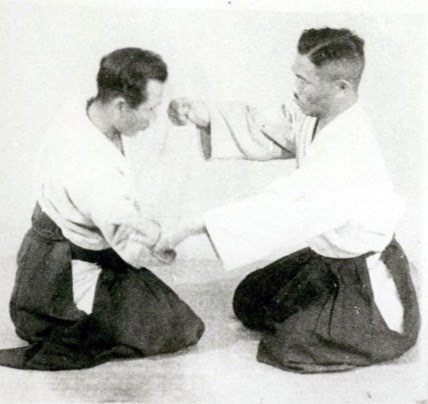 Seated technique from the Soden photo collection Vol. 5. taken c. 1936. Here, Yoshimura Yoshiteru (Kyoju Dairi) demonstrating a one-handed kotegaeshi wrist twist followed by an atemi to the opponent’s face similarly as it is described in the scroll. Uke: Kawazoe Kuniyoshi
Seated technique from the Soden photo collection Vol. 5. taken c. 1936. Here, Yoshimura Yoshiteru (Kyoju Dairi) demonstrating a one-handed kotegaeshi wrist twist followed by an atemi to the opponent’s face similarly as it is described in the scroll. Uke: Kawazoe Kuniyoshi
Juji-garami
In number six, uke grabs the opponent’s shoulders with the left hand and strikes the eyes with the right hand. In response, tori twists the opponent’s right hand to the left, put the opponent’s left hand on the opponent’s elbow, and push him down. The technique is described in Ueshiba Morihei’s Budo Renshu as well, however in this case from a munadori attack. The text uses the phrase Juji (十字) meaning to cross the opponent’s arms like the Kanji (Chinese character) ten (十), therefore this technique is called Juji-garami in Aikido. Even though this seated technique is not part of the modern Aikido curriculum anymore, its standing variation Katadori-menuchi Juji-garami is commonly practiced規範合気道基本編 by Ueshiba Moriteru.
 Jujigarami techniques from Ueshiba Morihei’s Budo Renshu from 1933, and the Noma dojo photo collection from 1936.
Jujigarami techniques from Ueshiba Morihei’s Budo Renshu from 1933, and the Noma dojo photo collection from 1936.
It seems that this technique is also practiced from Munadori Shomen-uchi attack in the Horikawa line, as well as the Tokimune line. Unfortunately, I couldn’t find this technique in the Soden photo collection.
 Inoue Yusuku Menkyo Kaiden, a former headmaster of Kodokai, demonstrating a Munadori Shomen-uchi technique.
Inoue Yusuku Menkyo Kaiden, a former headmaster of Kodokai, demonstrating a Munadori Shomen-uchi technique.
Kotegaeshi
Number eight is a Kotegaeshi technique from the Ryote-dori attack. In Iwabuchi’s scroll the technique is described as follows:
第八條 Item 8一、 目カクシヲ打チ敵ノ両手ヲ摑ム事 Strike the opponent’s eyes, and grab both of the opponent’s hands.
第八條 Item 8一、 柏手ヲ打敵ノ右手ヲ右ニテ捻リ左ノ手ニテ敵ノ手ヲ押ヘ捻倒ス事 Clap your hands, twist the opponent’s right hand with the right, control the opponent’s hand with your left hand, and twist down.
Before executing the kotegaeshi wrist twist, the scroll uses the phrase “kashiwade wo utsu” meaning to clap the hands. Kashiwade refers to the hand clap that people do when they offer prayers to gods at shrines. As a Shinto term, it could illustrate some relation to Hoshina Chikanori.
 Nomoto Tadashi Shihan demonstrating Kashiwade Kotegaeshi as it is transmitted in the Horikawa line. The final pin is not written in the scrolls and is probably a later addition of Takeda Sokaku or Horikawa Kodo.
Nomoto Tadashi Shihan demonstrating Kashiwade Kotegaeshi as it is transmitted in the Horikawa line. The final pin is not written in the scrolls and is probably a later addition of Takeda Sokaku or Horikawa Kodo.
A modified version of the text can be found in later versions of the Hiden Mokuroku scroll (probably from the 1910s onwards). Instead of “control the opponent’s hand with the left hand, and twist down” (左ノ手ニテ敵ノ手ヲ押ヘ捻倒ス事), it states: “grab the opponent’s thumb with your left hand, and twist down” (左ノ手ニテ敵ノ拇指ヲ摑ミ捻倒ス事)Based on studies of Nomoto sensei’s scrolls he kindly provided for this study..
Torihanashi no Koto
From item 9 to 12, the scroll follows with four attacking techniques. 9 and 10 describe Shiho-nage on right and left hands and 11 is (Uchikaiten) Sankajo. In these cases tori moves under uke’s arm. In seated situations this might be troublesome thus these techniques seem to disappear from Daito-ryu and Aikido curriculums. Item 12 is kotegaeshi. Similarly to item 3, tori reaches out and grab the ukes hand, however in this case tori uses two hands to twist the uke’s hand outside.
 Ueshiba Morihei demonstrating a two-handed kote-gaeshi techniques at Noma Dojo, in 1936.
Ueshiba Morihei demonstrating a two-handed kote-gaeshi techniques at Noma Dojo, in 1936.
In these cases, after the item number there is a note “Torihanashi no koto” (取リ放シノコト) meaning to release the opponent at the end of the technique.
Hanmi handachi?
In techniques number 13 and 14, the scroll explicitly says that uke holds or grabs both of tori’s shoulders standing from behind. In Aikido, this would fit in the category of Hanmi Handachi. In both cases, tori applies Sankajo in response.
 Hanmi-handachi Ushiro Ryokata-dori attack from the Noma Dojo collection, and Sankajo technique from the Soden collection Vol. 2.
Hanmi-handachi Ushiro Ryokata-dori attack from the Noma Dojo collection, and Sankajo technique from the Soden collection Vol. 2.
Altogether, there are fourteen techniques in the Zatori Jujutsu section and they are described through twenty-two items.
Hanza Handachi Jujutsu
Hanza Handachi (半座半立) literally translates as half seated half standing referring to the situation when the defender is sitting, and the attacker is standing. Although the scroll mentions Hanza Handachi, it seems that Sokaku used the phrase Hanmi Handachi (半身半立) to describe this situation. That latter naming is used in Sagawa and Horikawa lines as well as in Aikido.
The techniques in the Hanza Handachi section are as follows:
| Item | Attack | Defense |
|---|---|---|
| 15 | Ryote-dori | Shiho-nage |
| 16 | Katate-dori | Shiho-nage |
| 17 | Ryote-dori | Shiho-nage |
| 18 | Morote-dori | Shiho-nage |
| 19 | Ryote-dori | Yonkajo |
| 20 | Kotegaeshi |
The section contains four variations of Shihonage from Katate, Ryote, and Morote dori attacks. Versions of these techniques are commonly practiced in modern Aikido as well. In the following pictures, Ueshiba Morihei demonstrates Katate-dori and Ryote-dori Shihonage from Hanmi-handachi position. It seems that he made a distinction between these two situations, staying in a kneeling position against a one-handed grab, and standing up against a two-handed grab.
 Ueshiba Morihei demonstrating Hanmi-handachi Katate-dori Shihonage at the Noma Dojo in 1936 and Ryotedori Shihonage at the Kobukan Dojo in 1938.
Ueshiba Morihei demonstrating Hanmi-handachi Katate-dori Shihonage at the Noma Dojo in 1936 and Ryotedori Shihonage at the Kobukan Dojo in 1938.
On the other hand, Kawamata Kozo in his publication Gokui Hiden Goshinjutsu Kyojusho, stands up for Shiho-nage not only against Ryote-dori and Morote-dori but also against Katate-dori attack. Unfortunately, the original text in the Hiden Mokuroku does not clarify whether tori should stand up or stay seated.
 Hanmi-handachi shiho-nage from the Soden photo collection Vol. 2. taken c. 1936. Yoshimura Yoshiteru demonstrating the basic jujutsu form on the left, and the more advanced Aiki no Jutsu version on the right. Uke: Kawazoe Kuniyoshi.
Hanmi-handachi shiho-nage from the Soden photo collection Vol. 2. taken c. 1936. Yoshimura Yoshiteru demonstrating the basic jujutsu form on the left, and the more advanced Aiki no Jutsu version on the right. Uke: Kawazoe Kuniyoshi.
There are two examples of Hanmi-handachi Shiho-nage in the Soden photo collection, both from Katate-dori attack. The picture on the left shows the basic jujutsu form with the following explanation:
In the case when the left hand is grabbed with the right hand from the left side. At the same time you stand your left foot, extend your grabbed hand and grab the opponent's right wrist with the right hand. As you stand up, turn the opponent's hand above your head, throw him down facing upwards, and hold him down.
The variation on the right is described as follows:
Raise your grabbed hand, turn (the opponent) behind your head, and throw him to the other side. Note: This technique requires the most kokyu (呼吸), what is called Aiki no Jutsu (合気之術).
Although the picture doesn’t show it, Hisa Takuma’s explanation is very clear in that tori should stand up for basic katate-dori shiho-nage. On the other hand, for the variation tori stays seated and executes the throw without moving or grabbing the uke. Here, tori exclusively uses the connection with the uke’s palm to control him making it the Aiki version of the technique. The note is particularly interesting since it suggests that Kokyu and Aiki are synonyms. Hisa was a student of both Ueshiba and Takeda, thus Aikido and Daito-ryu terminology appears simultaneously throughout the Soden descriptions.
To sum it up, standing up is probably the oldest and most basic form of Hanmi-handachi Shiho-nage. Turning while kneeling is more advanced, and executing the technique without moving at all is the highest level, the so-called Aiki form of this technique.
The last technique in this section is a rather unusual one where it is tori who is standing and who executes Kotegaeshi on a sitting uke after having kicked his ribs.
The Hanza Handachi section lists 6 techniques described in 12 items.
Tachidori Jujutsu
Tachidori (立取) refers to standing techniques. In modern Aikido it is called Tachi Waza (立ち技). The table below summarizes the techniques in this section.
| Item | Attack | Defense |
|---|---|---|
| 1 | Shomen-uchi (right) | Ikkajo |
| 2 | Shomen-uchi (left) | Ikkajo |
| 3 | Shiho-nage | |
| 3 (not in 118) | Ushiro Katate-dori | Throw forward (Udekime nage) |
| 4 | Ryomuna-dori | Ikkajo |
| 5 | Ryoeri-dori | Shiho-nage |
| 6 | Ryote-dori | Throw over the shoulder (Seoi-nage) |
| 7 | Kata-dori | Ikkajo |
| 8 | Ryote-dori | Shiho-nage |
| 9 | Katate-dori | Throw over the shoulder (Seoi-nage) |
| 10 | Katate-dori | (Uchikaiten) Sankajo nage |
| 11 | Muna-dori | Shiho-nage |
| 12 | Katate-dori | Dislocate the shoulder |
| 13 | Katate-dori | (Uchikaiten) Sankajo |
| 14 Release (取放) | Shiho-nage | |
| 15 Release | Shouldering technique (Katsugi waza) | |
| 16 Release | Shiho-nage ura | |
| 17 Release | Elbow twist and pull down | |
| 18 Release | (Uchikaiten) Sankajo | |
| 18 Release (not in 118) | Dislocate the shoulder | |
| 19 | Atama-dori | (Juji-garami) |
| 20 | Ushiro Katadori | Sankajo |
| 21 | Ushiro Katate-dori | Throw froward (Udekime-nage) |
| 22 | Ushiro Katate-dori | Shiho-nage |
| 23 | Ushiro-dori (bear hug) | Sankajo |
| 24 Release | Ushiro kara Shiho-nage | |
| 25 Release | Ushiro kara Throw forward | |
| 26 Release | Ushiro kara Throw over the head (Ganseki-otoshi) | |
| 27 Release | Yoko kara Throw forward (Udekime-nage) |
Although thus far, the numbering of the items has been continuous, starting from Tachidori, it starts over from one.
Ikkajo
Just like in the Zatori section, Items 1 and 2 describe Ikkajo from Shomen-uchi strike on the right and left sides.
 Shomen-uchi Ikkajo from Sato Sadami’s Joshi Goshinjutsu (Woman Self-defense) published in 1917.
Shomen-uchi Ikkajo from Sato Sadami’s Joshi Goshinjutsu (Woman Self-defense) published in 1917.
These pictures are from Sato Sadami’s Joshi Goshinjutsu (Woman Self-defense), a book published in 1917, which makes it the oldest known publication of Daito-ryu techniques. Sato Sadami started his Daito-ryu training under Sokaku in 1900 and became Kyoju Dairi in 1904. As one of the earliest students of Sokaku, Sadami’s book is a valuable source for researching Daito-ryu techniques of the early years. Similarly to Kawamata Kozo’s book, uke attacks with the fist instead of the hand blade (tegatana). Tori controls the uke’s elbow with the left hand, and grab the uke’s right wrist with the right hand (left picture). Then pull it down (right picture) as it is described in the scroll.
On the other hand, Ueshiba Morihei seems to have had a different approach to this technique. Instead of waiting for the uke’s attack, he initiates the technique while striking the uke’s head and executs an atemi to the ribs at the same timeUeshiba Morihei, Budo Renshu, 1938.
 Ueshiba Morihei demonstrating Shomen-uchi Ikkyo (Ikkajo) at the Noma Dojo in 1936.
Ueshiba Morihei demonstrating Shomen-uchi Ikkyo (Ikkajo) at the Noma Dojo in 1936.
Although Morihei modified this technique in this way, interestingly, modern Aikido returned back to the “Daito-ryu way” where tori executes the technique in response to uke’s attack.
In the scroll, there are other examples of Ikkajo from ryomuna-dori (Item 4) and kata-dori (Item 7) attacks.
Sankajo
In all cases in Hiden Mokuroku, Sankajo is reached after passing under the uke’s arm (Uchi Kaiten). It seems that this way was the most basic form of Sankajo in the early days of Daito-ryu, perhaps because it doesn’t require to change the grab. On the other hand, in Aikido, Sankyo is most commonly reached from Ikkyo kuzushi. Interestingly, this kind of change from Ikkajo grab to Sankajo grab appears in the second scroll Hiden Okugi no Koto, and hence is considered to a be higher level application in Daito-ryu. The most common ending of Sankajo is to twist the Uke’s hand to his hip. Other ending variations such as pulling down the uke or throwing the uke forward (Sankyo-nage) show similarities to Aikido.
 Sankajo (on the right), pinning to the back of the hip (in the middle) and pulling downwards to pin on the ground (on the right). Pictures from the Soden photo collection Vol. 4. taken c. 1936.
Sankajo (on the right), pinning to the back of the hip (in the middle) and pulling downwards to pin on the ground (on the right). Pictures from the Soden photo collection Vol. 4. taken c. 1936.
Shiho-nage
The most common technique in the scroll is Shiho-nage usually described as:
Pass the opponent’s hand above your head, turn your body and throw.
Item 8 describes Ryote-dori Shiho-nage, which is a basic technique in the curriculum of modern Aikido as well. There are other examples of Shiho-nage from ryoeri-dori (item 5), muna-dori (item 11), and ushiro katate-dori (item 22) attacks as well as attacking variations (item 3, 14, 16 and 24).
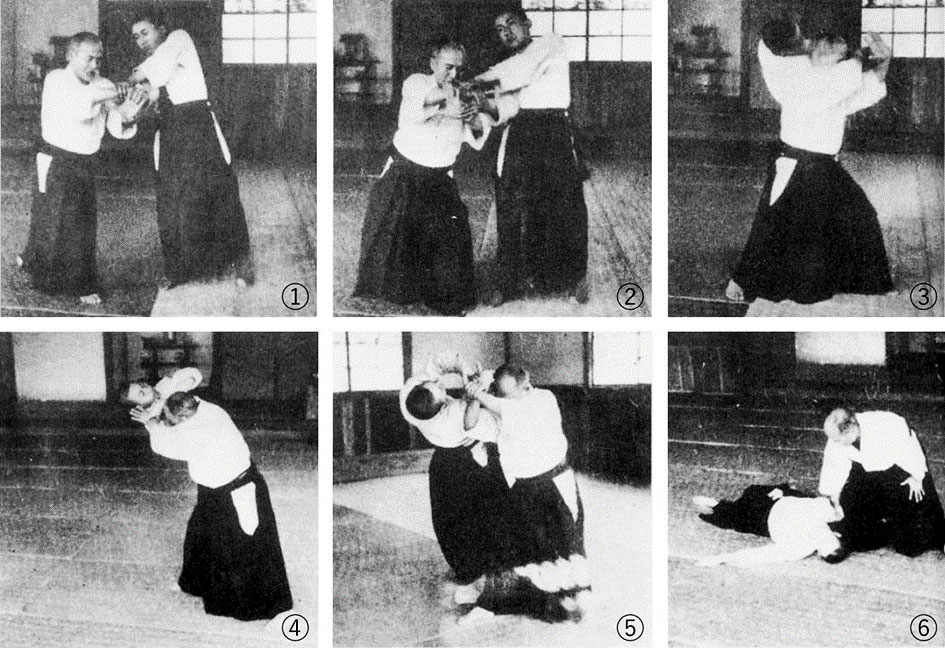 Ryote-dori Shiho-nage demonstrated by Ueshiba Morihei at the Kobukan dojo in 1938. Uke: Ueshiba Kisshomaru.
Ryote-dori Shiho-nage demonstrated by Ueshiba Morihei at the Kobukan dojo in 1938. Uke: Ueshiba Kisshomaru.
Udekime-nage
There are a number of explicit throwing techniques in the scroll, which are usually described as:
Put the opponent’s arm on your shoulder and throw forward.
It is not known how these techniques were called in Sokaku’s time, thus in the table I used an Aikido term: Udekime-nage or “arm lock throw”. Related throwing techniques in the Tachi-dori section are items 3, 21, 25 and 27.
 Throwing technique demonstrated by Horikawa Kodo. Uke: Okamoto Seigo.
Throwing technique demonstrated by Horikawa Kodo. Uke: Okamoto Seigo.
Kata-gime
Item 12 reads as
Put your opponent’s arm on your shoulder, and dislocate the opponent’s shoulder
describing a shoulder lock or “kata-gime”. Item 18 might be the same technique although the description is not very clear.
 Shoulder lock demonstrated by Yoshimura Yoshiteru from Soden Vol. 3. Uke: Nakatsu Heizaburo.
Shoulder lock demonstrated by Yoshimura Yoshiteru from Soden Vol. 3. Uke: Nakatsu Heizaburo.
Seoi-nage
A more well known variation of this technique is seoi-nage. The scroll describes it as:
Put the opponent’s arm on your shoulder, and throw over the shoulder.
This technique is applied against Ryote-dori (item 6) and Katate-dori (item 9) in the scroll.
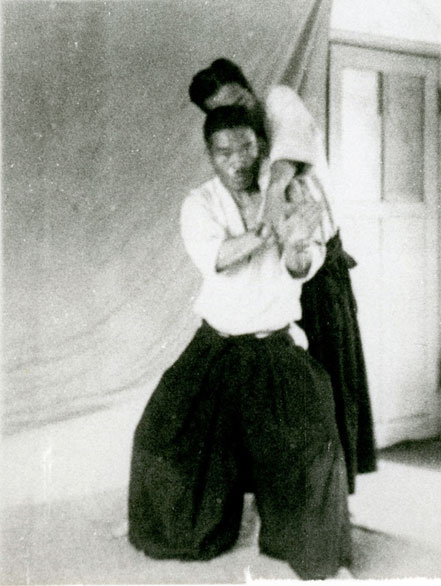 Throwing over the shoulder from Ryote-dori attack as it is described in Item 6 of the Hiden Mokuroku. Picture from Soden Vol. 5.
Throwing over the shoulder from Ryote-dori attack as it is described in Item 6 of the Hiden Mokuroku. Picture from Soden Vol. 5.
Katsugi Waza
Item 15 describes an attacking technique as:
Grab the opponent’s hand and twist it up, connect your shoulder to the opponent’s hip and lift him facing upwards.
Katsugi waza translates as "shouldering technique" and the term is used in the Horikawa line. Yamamoto Kakuyoshi, and Takeda TokimuneDaito-ryu Aikijujutsu 118kajo, Ishibashi Yoshihisa called this technique “Shumoku” (撞木), however, it is not known if Sokaku called it like that.
 Shouldering technique from Soden Vol. 5.
Shouldering technique from Soden Vol. 5.
Ganseki-otoshi
Item 26 describes a technique when tori grabs uke’s collar from behind and throws the uke above the head. The technique appears in the Noma photo collection from 1936.
 Ueshiba Morihei demonstrating Ganseki-otoshi at Noma Dojo, in 1936. Uke: Yonekawa Shigemi.
Ueshiba Morihei demonstrating Ganseki-otoshi at Noma Dojo, in 1936. Uke: Yonekawa Shigemi.
Ganseki-otoshi, Katsugi-waza and Seoi-nage seem to have been taught by Ueshiba Morihei before the war, however, due to their dangerous nature, these techniques clearly disappeared from the official curriculum of postwar Aikido.
Atama-dori
Item 19 describes an unusual attack where uke grabs tori’s head with both hands. The situation appears in this video of Horikawa Kodo at 2:53, however, here he demonstrates Atama-Aiki. Instead of grabbing the uke’s hands and twisting them to the side as it is described in the scroll, he applies techniques using the connection surface with the opponent’s palm exclusively, making it the Aiki form of the technique.
Ushiro Waza
Items from 20 to 26 describe Ushiro waza or rear techniques. Items 20 to 23 are defensive techniques where uke grabs tori from behind and then tori applies a technique. On the other hand, items 24 to 26 are attacking techniques where tori stands behind uke and grabs his wrist or clothes to execute a throw. In the case of the last technique, item 27, tori and uke stand next to each other. It is an attacking technique: tori grabs the uke’s wrist and throws him forward.
Techniques that describe tori moving under their opponent’s arm are very common in this scroll. One can postulate that it may have to do with the the fact that Sokaku was very short (around 150 cm) and that these kinds of techniques were advantageous for him.
Although there are 46 items written in this section, two items (3 and 18) end with a mention saying: “this technique is not included in 118 kajo (items)” (但し百拾八ヶ条の外). Thus, this section accounts for 44 items, which describe 27 actual techniques.
Ninin Zume no Koto
Ninin-zume can be translated as pinning two opponents. These techniques start from the position when two opponents grab tori from left and right or back and front. In Aikido, this is called Ninin-dori, however, there is a technical difference. While in Aikido, throwing techniques are common in this situation, in Daito-ryu, the opponents end up piled on top of each other, pinned down by tori’s knee.
There are 8 items listed in the section, however, the last two are not describing a technique but are additional notes explaining that in the cases when one faces three or four opponents, the technique must be done based on the same principle. Thus, the Ninin-zume section accounts for 6 items describing 3 actual techniques.
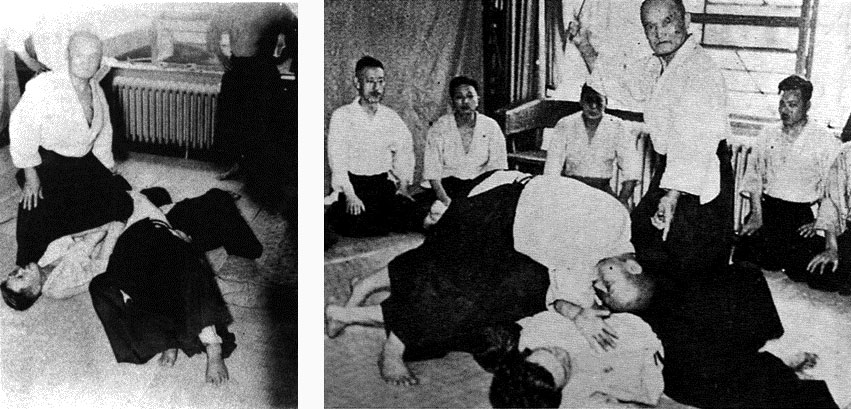 Sokaku demonstrating a pinning technique against two opponents on the left and applying the same principle against four opponents on the right at Asahi Newspaper Dojo in 1938.
Sokaku demonstrating a pinning technique against two opponents on the left and applying the same principle against four opponents on the right at Asahi Newspaper Dojo in 1938.
Kasadori no Koto
Kasa dori means umbrella taking. In this case, tori is holding an umbrella and uke grabs either tori’s hand or the shaft of the umbrella. In response, tori grabs the uke’s wrist and applies Shiho-nage. The section describes one technique in two items.
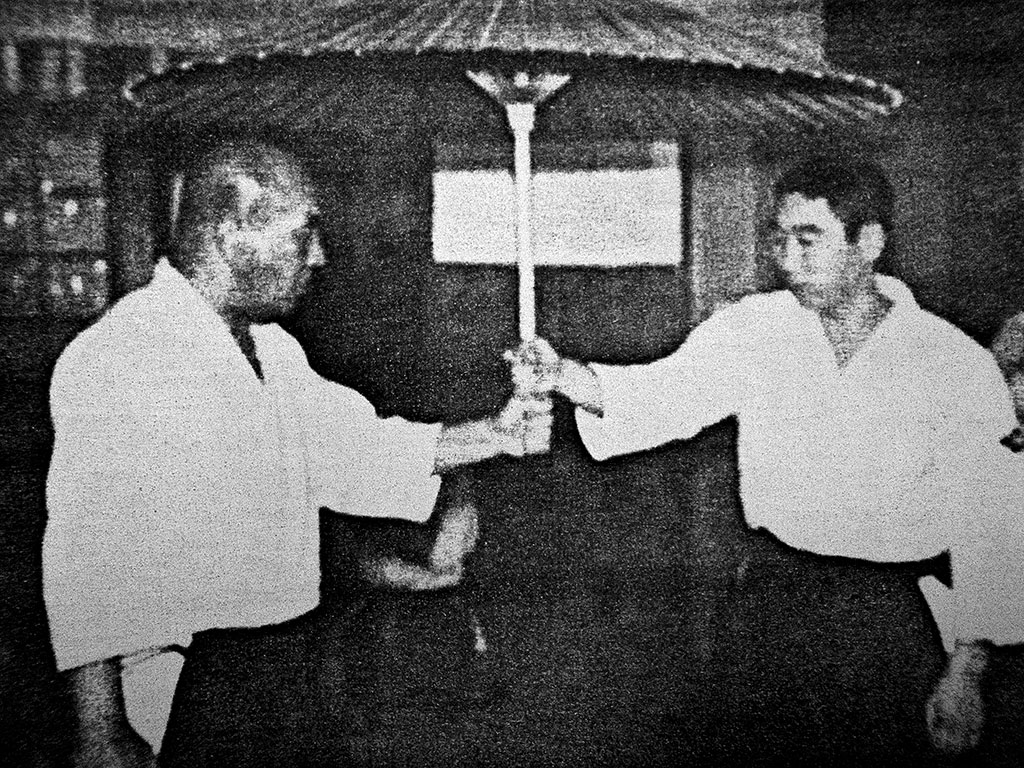 Makita Kan’ichi Sensei demonstrating Kasadori.
Makita Kan’ichi Sensei demonstrating Kasadori.
We know that Ueshiba Morihei handed out Hiden Mokuroku scrolls to his students before the war, and with slight modifications occasionally even after the war. The following scroll is from 1960, titled Aikido Hiden Mokuroku. It follows the structure and order of Takeda’s Hiden Mokuroku with some slight modifications.
 Aikido Hiden Mokuroku scroll from 1960 given out by Aikido Doshu Ueshiba Tsunemori (Morihei). In this final segment of the scroll, we can see the umbrella taking technique followed by Bojutsu no Koto or staff techniques. For more on this scroll you can head over to Aikido Sangenkai's blog.
Aikido Hiden Mokuroku scroll from 1960 given out by Aikido Doshu Ueshiba Tsunemori (Morihei). In this final segment of the scroll, we can see the umbrella taking technique followed by Bojutsu no Koto or staff techniques. For more on this scroll you can head over to Aikido Sangenkai's blog.
In this final segment of the scroll, an umbrella taking technique is listed. Although the final item is modified to Bojutsu no Koto (stick technique), it’s interesting that Ueshiba kept the umbrella technique in the scroll even though it is not part of the Aikido curriculum.
Obi-seshi Katana no Tsuka wo Tsukamaruru Koto
The long name describes the situation when uke grabs the grip of the sword that tori is wearing at his belt. Similarly to Kasa-dori, tori grabs uke’s wrist and executes a Shiho-nage throw. The section describes one technique in two items.
 In the scroll, instead of katana no tsuka (刀ノ柄, grip of the sword), katana no tomo (刀ノ鞆) is written. Tomo is a leather wrist protector used in Japanese archery. Since the characters are very similar, it is most likely a typographical error in the scroll, and the text likely refers to tsuka-dori, as demonstrated by Horikawa Kodo on the left.
In the scroll, instead of katana no tsuka (刀ノ柄, grip of the sword), katana no tomo (刀ノ鞆) is written. Tomo is a leather wrist protector used in Japanese archery. Since the characters are very similar, it is most likely a typographical error in the scroll, and the text likely refers to tsuka-dori, as demonstrated by Horikawa Kodo on the left.
The technical notes end with the lines:
 Giemon’s Daito-ryu Jujutsu Hiden Mokuroku scroll. The red and blue numbers denote the number of items and techniques in each section respectively.
Giemon’s Daito-ryu Jujutsu Hiden Mokuroku scroll. The red and blue numbers denote the number of items and techniques in each section respectively.
The number of items in the six sections adds up to 88. Adding the 30 unwritten (outside 外) items to those, we get 88條 + 30外手 = 118條 items in total. The 88 items describe altogether 52 techniques (36 defensive and 16 offensive). The large number of offensive techniques, and the frequent usage of Atemi to the eyes or ribs might be the outcome of Sokaku’s experience in real (sword) fighting in his twenties. As Sokaku often said:
In real fighting the initiative (sword) is important (真剣勝負では初太刀が大事だ) Daito-ryu Aikijujutsu 118 kajo, Ishibashi Yoshihisa
In addition, all techniques described in the scroll are Jujutsu techniques, meaning that tori (usually) grabs uke’s wrist to apply a joint lock or throw.
Now, I would like to focus on the 30 mysterious items that are not explicitly written in the scroll. The scroll doesn’t mention Nikajo-like techniques, thus it is possible that they were included in this unwritten section. In addition, interestingly the number 30 appears in Ueshiba’s Hiden Okugi no Koto certificate from 1922. As we have seen in the previous article in this series, Menkyo Kaiden and the Evolution if Daito-ryu Certificates, the content of Ueshiba’s certificate is as follows:
- 118 kajo ura omote (百拾八ヶ条 裏表)
- Aiki no jutsu ura 30 kajo (合氣之術 裏参拾ヶ条)
- Hiden okugi 36 kajo (秘伝奧儀 参拾六ヶ条)
118 kajo refers to the first Hiden Mokuroku scroll, and 36 kajo refers to the second Hiden Okugi scroll in this list. Interestingly, 118 kajo mentions ura and omote, however, Aiki no Jutsu describes only 30 ura items. Considering that omote and ura can mean public and secret, we can speculate that the 88 items written in the Hiden Mokuroku scroll are the omote or Jujutsu techniques, and the 30 items that are not written in the scroll are the ura or secret Aiki no Jutsu techniques. Aiki techniques were not for everybody, thus they are not written explicitly in scrolls. Thus, we can assume that these 30 items describing 15+ techniques were Aiki-nage (kokyunage in Aikido) like throwing techniques, and a few variations of Nikajo (Nikyo) wrist techniques. Furthermore there is an interesting note on Nikajo in Hisa's Soden. Most of the Nikajo techniques in it are described as:
Lock with Kokyu (呼吸にて極める)
As we saw before, Kokyu and Aiki are synonymous terms, suggesting that Nikajo was considered to be a sort of manifestation of Aiki.
 Ueshiba Morihei demonstrating Nikyo variations from sitting position at Noma dojo in 1936.
Ueshiba Morihei demonstrating Nikyo variations from sitting position at Noma dojo in 1936.
Summary
Sokaku started teaching Daito-ryu and issuing scrolls after he met with Hoshina Chikanori in 1898 and there is no existing written mention of the art before that, that we know of. There were two scrolls from the beginning, the first scroll is titled Daito-ryu Jujutsu Hiden Mokuroku. Daito-ryu techniques didn’t have a name at that time, thus the scrolls are written in a form of notes called kajo (items). The first scroll mentions 118 items; however, 88 items are explicitly written in the scroll describing 52 techniques. Some of them became basic techniques of Aikido such as Ikkyo, Sankyo, Shiho-nage, Kotegaeshi etc. The large number of attacking techniques and emphases on atemi highlight the effectivenes of Sokaku’s Daito-ryu in his early years. The 30 not written items might have some conection to Aiki or Nikajo techniques.
In Part 2, we are going focus on the second half of the scroll describing the lineage.
Special thanks to Guillaume Erard for his help with the documentation and advice during the redaction of this article. Thank you to Josh Gold from Aikido Journal for letting us use their database. In addition, I would like to express my gratitude to Nomoto Tadashi sensei for the useful discussion and the documents he provided for this research.


